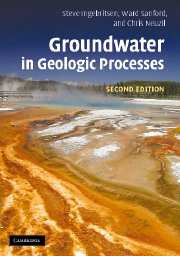Book contents
- Frontmatter
- Contents
- Preface
- Acknowledgements
- List of symbols
- 1 Groundwater flow
- 2 Hydromechanical coupling
- 3 Solute transport
- 4 Heat transport
- 5 Regional-scale flow and transport
- 6 Ore deposits
- 7 Hydrocarbons
- 8 Geothermal processes
- 9 Earthquakes
- 10 Evaporites
- 11 Compaction and diagenesis
- 12 Metamorphism
- 13 Subsea hydrogeology
- References
- Index
10 - Evaporites
Published online by Cambridge University Press: 12 January 2023
- Frontmatter
- Contents
- Preface
- Acknowledgements
- List of symbols
- 1 Groundwater flow
- 2 Hydromechanical coupling
- 3 Solute transport
- 4 Heat transport
- 5 Regional-scale flow and transport
- 6 Ore deposits
- 7 Hydrocarbons
- 8 Geothermal processes
- 9 Earthquakes
- 10 Evaporites
- 11 Compaction and diagenesis
- 12 Metamorphism
- 13 Subsea hydrogeology
- References
- Index
Summary
Evaporites are sediments deposited from natural waters that have been concentrated as a result of evaporation. The source waters can be either marine or continental in origin. Evaporite deposits are important sources of gypsum, halite, sylvite, and other economically important minerals. The genesis of these deposits is controlled partly by the movement of groundwater into and/or out of basins that are hydrologically closed with respect to surface-water outflow. During the evolution of an evaporite deposit, both the quantity (fluxes) and quality (chemistry) of local groundwater can control salt deposition.
Substantial thicknesses of evaporites are buried in some sedimentary basins. There, they act as important barriers to groundwater flow, but they are also susceptible to dissolution by groundwater. Buried evaporites can migrate slowly upward through overlying sediments in the form of salt domes. The interaction between groundwater and salt domes results in variable-density convection adjacent to the dome and diagenesis at the top of the dome. In this chapter we organize and discuss the role of groundwater in termsof these four different stages of evaporite evolution: formation, burial, dissolution, and diapiric rise.
Evaporite formation
In this section we introduce the theoretical evaporite sequence that would be produced by closed-basin evaporation of seawater, and we compare this sequence with those actually observed in nature. We then proceed to show how the discrepancies can be explained by the role that groundwater plays in adding and removing solutes from evaporite basins. We also discuss the role of groundwater in continental evaporite deposits.
The marine evaporite problem
It has long been known that by simply evaporating seawater one can obtain approximately the same salts that are observed in most major evaporite deposits (Usiglio, 1849). However, in spite of the fact that both the theoretical and observed evaporation sequence will produce calcium sulfate, halite, and the more soluble salts of calcium and magnesium chloride, some notable deviations occur (Figure 10.1). The differences between theory and observation include (1) the relative abundance of observed calcium sulfate, (2) the absence of magnesium sulfates in many deposits, (3) the presence of sylvite in some deposits, and (4) the presence of tachyhydrite in some deposits. Theory predicts the precipitation of the sulfate minerals, but in amounts that differ from typical deposits. Theory also predicts that sylvite and tachyhydrite should not precipitate, yet they are observed in many deposits.
- Type
- Chapter
- Information
- Groundwater in Geologic Processes , pp. 325 - 351Publisher: Cambridge University PressPrint publication year: 2006

